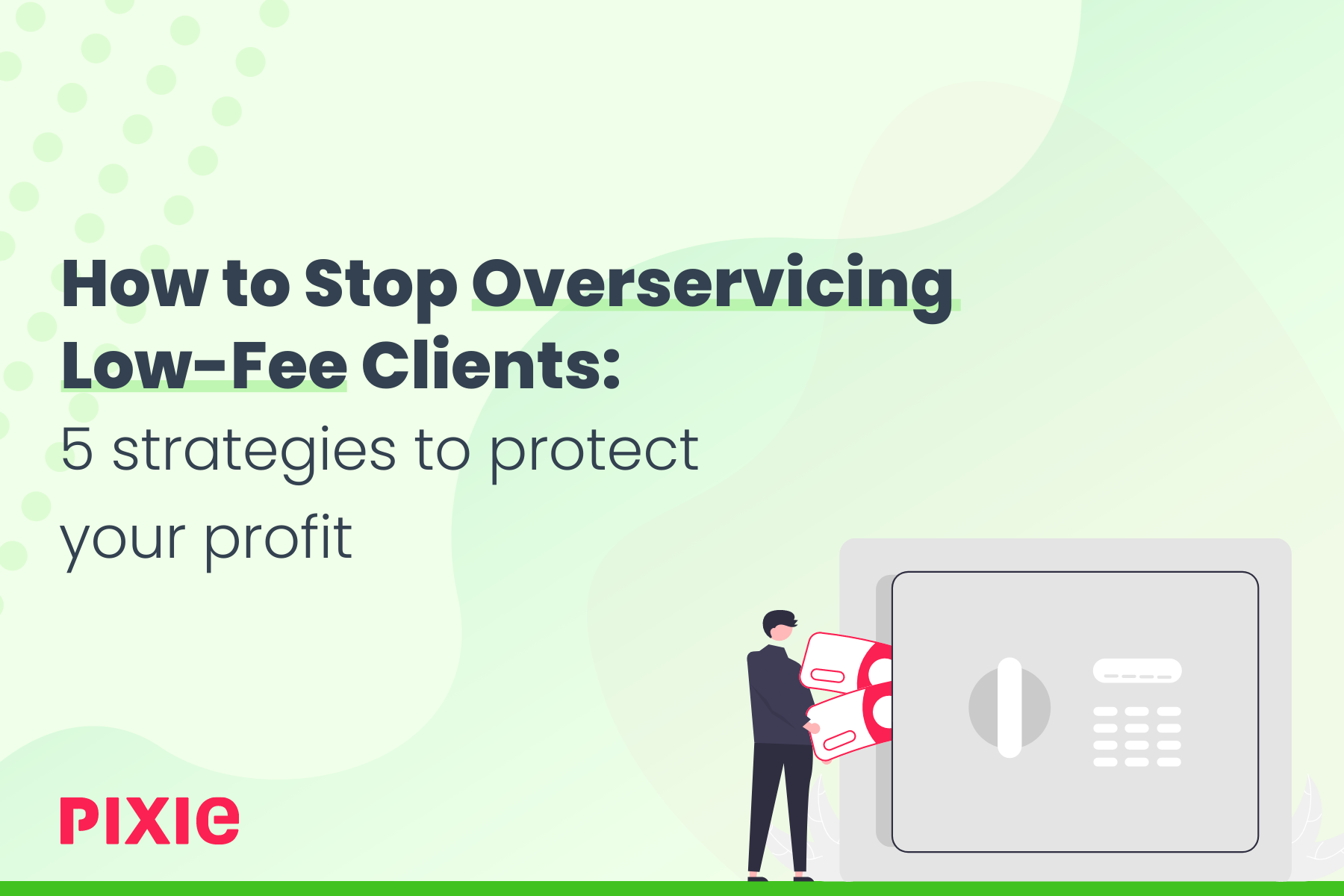How to Stop Overservicing Low-Fee Clients — Pixie
We've outlined how you can stop overservicing low-fee clients and have a healthier bottom line.

As someone running an accounting firm, you've probably come across the concept of overservicing before. If I’m being honest, it's caught us all out at one time or another.
Overservicing is when we, as business owners, do more work than our clients are paying for. For example, a client might have a small budget, and to keep them happy, you deliver more than you're being paid to deliver. Or perhaps you spend more time talking to your client on the phone than you should.
Overservicing is a problem in the sector. In fact, research conducted by Agency Works found that almost 70% of B2B and consumer agencies are overservicing!
It's an easy trap to fall into. But overservicing wastes precious time that could be spent elsewhere and reduces profitability in the process.
The ideal client for an accountancy firm is a low-volume, high-paying client. After all, the goal is to spend less time on clients but make more money for each hour worked.
The good news is that these low-volume, high-paying clients do exist, and by putting a stop to overservicing, you can make more time from high-paying clients and improve your profitability significantly.
Let me tell you how.
How overservicing is negatively impacting your firm
Overservicing is likely negatively impacting your firm, which it does in three main ways:
Reduces profits
First and foremost, overservicing clients reduces profits, which is any business's worst nightmare! You may unintentionally eat into a big portion of your profits by completing non-billable tasks, offering costly discounts to clients, or spending too much time on unnecessary calls and admin.
Less time available to spend on high-value clients
The more time you spend on low-fee clients, the less time you have to spend on high-value clients. By resolving the overservicing issue, you’ll have additional time to focus on attracting new, high-value clients, leading to a higher recovery rate. It's a win-win situation!
It sets a precedent
Overservicing a client too often sets a negative precedent for the future. While it may start with one small favour, it’s a slippery slope to completing more and more work than they are paying for. Your clients may begin to expect free work, which can be a tough challenge to navigate. This is especially true for firms that don't have sufficient checks in place to make sure they aren't overservicing.
Plus, routinely supplying free work to low-fee clients suggests to the outside work that the firm provides a low-value service. This could negatively impact the perception of your firm in the eyes of the high-value prospects you want to attract.
Working with low-fee clients does not necessarily mean your work is low-value — even the smallest of businesses need access to financial advice — however, making a habit of overservicing these clients can put up barriers to growth.
How to stop overservicing clients
Changing your behaviour and habits won’t just improve your balance sheet; it'll also enhance your firm's reputation.
Here are some solutions to help you stop overservicing clients so you can increase profits, spend more time working with high-value clients and improve brand perception:
Set clear boundaries to prevent scope creep
It's safe to say that we've all experienced scope creep at some point in our careers. It begins with a simple request, one that doesn’t make sense to charge extra for, and before you know it, you’re delivering three extra reports a year, free of charge.
When we see the first signs that scope creep is happening, the best course of action is to set crystal clear boundaries. Define the scope of the work in a written format and confirm who is responsible for each task, and set a concrete deadline. If additional work is needed, outline how this will affect their payments or suggest another similar task is removed from the scope to make room for the new request.
Effective time and task management are essential to preventing scope creep. Pixie allows you to streamline workflows, breaking large tasks down into smaller steps. Understanding exactly what is required to complete each task, identifying who is responsible, and tracking changes and progress are all made easy with insightful reports. With this information, you’ll have a clear view of your scope and be able to better manage when it begins to creep.
Keep track of any extra work you complete
If you find setting boundaries doesn’t prevent your clients from asking for additional work, keep a log of any extra tasks your team takes on but that the client hasn’t paid for.
During your next client meeting, carefully raise the issue of scope creep again. It is important not to ambush the client or make them feel guilty; you are simply establishing boundaries and making them aware of an issue they likely don’t even know exists.
The log will help you explain the additional work you’ve done for them and help create a plan for the future. Hopefully, making them aware of the issue will encourage them to stay within the scope or increase their budget.
Avoid unnecessary calls
There are many ways firms can overservice clients, but a common habit is spending too much time on calls. This can include catch-ups regularly running over or accepting ad hoc calls too regularly. Thankfully, there are several ways to combat this problem.
The goal here is to be less client-facing without damaging the client relationship. To reduce the number of unnecessary calls you take, create standardised email templates that answer common client questions. That way, when a client reaches out with a request, you can send them a pre-created response rather than spending time writing out an answer or jumping on a call.
It can also be helpful to build a resource of useful information that is easily accessible to clients at all times, like a content library or database of how-to videos, so they only contact the firm for advice and support when absolutely necessary.
Supporting your clients is an incredibly important part of your job, but spending too much time on the phone will damage your firm's bottom line.
Review your pricing model
For firms that rely on fixed-pricing payment models, going above and beyond can be costly. If your current fixed-price model is exacerbating issues with overservicing, it might be time to begin billing your clients by the time used. Alternatively, negotiate a larger retainer with your client to cover the extra work completed by you and your team.
Use a workflow management system to cut out repetitive admin tasks
We know that it's easy to fall into the habit of spending too much time on admin tasks. Luckily, there's a solution — Pixie allows you to set up repetitive admin tasks as automations which recur as often as needed.
You can save tasks as templates for future use in just one click, which can be used on an ad hoc basis or set to recur automatically. You'll be surprised at just how much time setting up the same task every week or month wastes!
Final thoughts
Taking measures to limit the amount you overservice low-fee clients will offer many benefits, from improving your bottom line to freeing up the time you have to spend on high-value clients.
Most inefficiencies experienced by accounting firms come down to poor workflow management. The same is true when we overservice clients because we spend too much time on admin tasks, avoid automating repetitive requests and lack visibility of time spent.
A great way to avoid overservicing is to use Pixie. With everything you need to manage clients, workflow, emails, deadlines, and your team in one flexible app, this practice management software is sure to help your firm’s workflows run like clockwork.

About the author
Celso Pinto
A Portuguese expat in London, Celso founded Pixie after learning first-hand about the challenges faced by small accountancy and bookkeeping practices. A product-focused leader with over 20 years experience in the software industry, at Pixie you'll frequently find him listening to customers and distilling their feedback into the product and go-to-market strategy.


